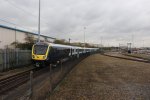Brent Goose
Member
On Monday’s trip from Weymouth (on diversion via Havant presumably due to engineering work) I ended up in the section where the Pantograph would be so there were no overhead spaces for people’s luggage.
Is this feature because they share a ‘platform’ with a type that does work with OHLE or was there some expectation that the third rail system might be ripped out - which seems unlikely in most of our lifetimes?
(Apologies if this has been discussed before but I didn’t see anything when searching the forum)
Is this feature because they share a ‘platform’ with a type that does work with OHLE or was there some expectation that the third rail system might be ripped out - which seems unlikely in most of our lifetimes?
(Apologies if this has been discussed before but I didn’t see anything when searching the forum)
Last edited:

